Cesare d’Este was the protagonist of one of the most difficult and negative phases in the history of the House: first, for having impersonated the extreme and useless attempt by Alfonso II to maintain possession of Ferrara despite being an illegitimate heir in the eyes of the Church, then for having led the departure to Modena, which together with Reggio and a few other possessions represented all that remained of the great Estense Duchy. His surrender to Clement VIII, who had excommunicated him, saved the duchy from an untenable and impossible to win war, but still left the Este family with prestige and power, as well as several territories. If with Cesare the glorious past of his family linked to Ferrara came to a definitive end, he nevertheless guaranteed his successors the possibility of writing a new future, albeit with often unpopular choices.
The life
Cesare d’Este was born on 1 October 1562 to Alfonso d’Este, Marquis of Montecchio, and Giulia Della Rovere, daughter of the Duke of Urbino Francesco Maria I Della Rovere. He lost his mother at a very early age and his father entered into a second marriage with Violante Segni, by whom he had two more children: Ippolita and Alessandro, who was to become Cardinal and Governor of Tivoli.
Not much is known about his childhood, but we do know that he was given a good literary education, to which the young Caesar preferred hunting and other more frivolous pastimes. As a result, he was not even enthusiastic about taking a wife: Virginia de’ Medici, sister of the Grand Duke of Tuscany, was chosen for him. The marriage was celebrated in Florence three years after the betrothal contract, on 6 February 1586: on their return to Ferrara, the couple stopped first at Belvedere, then continued on to Palazzo dei Diamanti, which they had received as an inheritance from Cardinal Luigi d’Este.
Becoming Duke for the survival of the Duchy
Alfonso II, having lost hope of a legitimate heir, considered only two possible names to be his successors: his cousins Cesare and Filippo, Marquis of San Martino in Rio, whose degree of parentage, the so-called ‘sigismondino’ family branch, was weaker. The Duke chose Cesare and indicated him in his will as his heir and successor: thus, after his death on 27 October 1597, at the reading of his will in the presence of the Judge of the Sages and other court officials, Cesare was designated Duke.
In spite of his moderate character, Caesar decisively took command of a very complicated situation, initially giving the impression that he did not care about the legitimacy of his succession: in fact, following custom, he took the oath of allegiance and after the bishop’s blessing sent his ambassadors to the other states to spread the news. Count Girolamo Giglioli was entrusted with the delicate ambassadorship to the Papal States and he arrived in Rome on 2 November. Clement VIII, born Ippolito Aldobrandini, however, rudely dismissed him, pointing out that Caesar was occupying Church territory without right. The Pontiff, like his predecessors, could in fact appeal to the Bull of Alexander VI, who had extended the investiture of Ferrara ‘ad omnes descendentes’ of Ercole I. And Caesar was not, but this did not mean that he renounced the power he had just obtained. Thus, also to prevent possible tumults or defend himself against invasions, he had to change strategy: he immediately sent his brother Alessandro to take possession of the cities of Modena and Reggio, which were the most at risk. Having secured the borders, the main problem remained internal: the ducal coffers had dried up and this represented a major disadvantage in the event of a war against the Papal States. When Clement VIII learnt that Caesar had refused to leave the illegally occupied territories, he set up a commission of nineteen cardinals to advise and support him in his desire to take over the territory of Ferrara. The Pope wasted no time and as early as 4 November, with the commission’s approval, issued a document stating that the Duchy was devolved ‘ob lineam finitam’ to the Church, that Cesare occupied it against all rights and that he would therefore have to leave it, on pain of excommunication: he was given fifteen days to present himself in Rome to justify his position. Both sides did not back down: Caesar did not appear before Clement VIII, who first prepared an army of thirty thousand men at Faenza, then excommunicated him. The Duke was warned of the excommunication on 25 December during Christmas Mass. Even the timing was not accidental: Caesar, animated by a strong religious feeling, sank into despair, fearing for the salvation of his soul. He therefore tried to stall for time and gave orders to close all the city gates so that the papal envoy would not be able to notify the condemnation. But this could not last long and in fact, on 30 December, the papal bull managed to enter the city and reached the bishop’s hands: it was the beginning of the end of the Este family’s long rule in Ferrara.
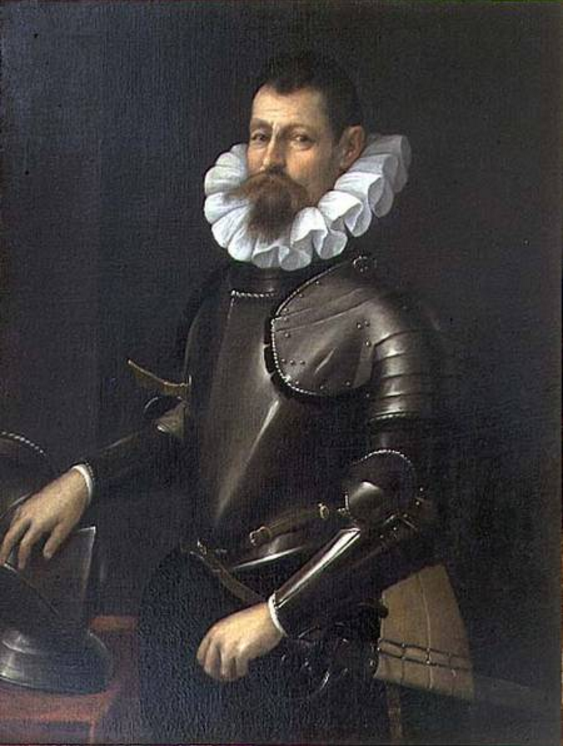
The Loss of Ferrara and the Convention of Faenza
The political and diplomatic situation became increasingly tense: on the one hand, the support promised by other Italian and foreign states such as Spain and France failed to materialise, and on the other, some towns such as Comacchio, Lugo, Cento and Pieve, having learned of the excommunication, rose up against the Este family.
Fearing the worst, Margherita Gonzaga and Eleonora, the Duke’s sister and wife of the Prince of Venosa, left Ferrara. Cesare in the meantime realised that he also had enemies within his Court and even in the Council of State: there were many Ferrara citizens who, anticipating the Duke’s surrender, soon switched to the service of the Church.
After all, the condition in which the Duchy found itself was clear and evident: the Duke, intimidated by the excommunication, with no financial resources and no army able to compete with the power of the Papal State, could not find the support of possible allies precisely because of the influence and prestige of his rival. Not to mention that the Court was full of informers who revealed the Duke’s decisions to the Pontiff.
Cesare was therefore unable to stand up to papal authority and decided to appoint Lucrezia d’Este, Duchess of Urbino and sister of the late Alfonso II, as mediator to negotiate the delicate agreement with the Church, seeking the best way to protect the interests of the Este family. This choice has been widely discussed by historiographers: on the one hand, in fact, Lucrezia had excellent relations with the Aldobrandini, but on the other, she still felt a deep resentment towards Cesare for what her cousin, Alfonso II, had committed. Twenty-five years earlier, in fact, Duke Alfonso II had had Lucrezia’s lover, Ercole Contrari, killed for political reasons: between the two there was a deep relationship that had brought a period of joy in the lady’s unhappy life.
Lucrezia accepted the assignment and on the morning of 31 December 1597 set off for Faenza, taking on a journey that proved to be very tiring due to both the cold winter weather and the lady’s age and serious health condition. In Faenza, she was expected by Cardinal Pietro Aldobrandini, the Pontiff’s nephew, who was in charge of diplomatic negotiations. The agreements, which were quickly concluded, were anticipated by the armistice, after the presentation of the ducal insignia in the hands of the Judge of the Sages and both Alfonso, Cesare’s eldest son, who had been Aldobrandini’s prisoner during the entire period in Faenza.
On 12 January, a document was drawn up consisting of fifteen points on which the Convention of Faenza was based in which Cesare renounced the territories of Ferrara, Cento and Pieve and the places in Romagna and, in exchange, was absolved of excommunication. Cesare was allowed to take with him the movable property, the archives and half of the artillery and, above all, the patronage of the Prepositura di Pomposa and the Pieve di Bondeno remained his property, as well as the alodial properties in the given territories. On 28 January 1598, the edict was published in the press, which took the name of ‘Capitulations’, which spread the agreement reached between Duke Cesare and Pope Clement VIII. The next day the Duke, after attending the last mass in the Cathedral of Ferrara with the subsequent blessing by the bishop, left the city to start his new life in Modena. On 29 January 1598, the Este family definitively left Ferrara, which had been administered by the duchy since 1477. On 30 January Cardinal Aldobrandini entered the city, taking possession in the name of the Pope.
In the light of these facts, the figure of Cesare can be assessed from two different points of view: on the one hand he is judged as inept and bigoted, too attentive and obsequious towards the Holy See, on the other hand he managed to avoid a bloody war with the risk of also losing the territories of Modena and Reggio, two cities with inadequate fortifications to face the conflict against the papal army.
Even after the Devolution Cesare remained devoted to the Holy See: this is confirmed by the meeting in Rimini with Clement VIII in May 1599, in which the Duke personally confirmed his full devotion. This much-discussed and unpopular gesture, however, led to a positive outcome as, also in 1599, the Pope elected Cesare’s brother Alessandro d’Este a cardinal. The stronger and more determined character of the latter and his high ecclesiastical office brought the Toson d’Oro to Cesare in 1606 and two years later the marriage between his nephew Alfonso and Isabella, daughter of Carlo Emanuele I of Savoia and Catherine of Habsburg.
Other claims on the Estense territories
Having resolved the issue with the Papal States, it cannot be said that with the loss of Ferrara the internal family quarrels were over. Lucrezia d’Este herself, a key pawn in this phase, died just two weeks after the Devolution (12 February 1598), but managed to carry out her revenge. The dame, in fact, had not only indicated Cardinal Aldobrandini as her heir, but had also repeatedly demanded her portion of the estate from her father Ercole II’s inheritance and, due to clauses in the latter’s will, Cesare had to give up other important palaces, such as the palace on the Grand Canal in Venice and the Palazzo Belvedere in Ferrara.
Then came Anna d’Este, also the sister of Alfonso II and Duchess of Nemours in France, who demanded her father’s allodial possessions on French territory: thus the Duchy of Chartres, the Viscounty of Caen, the seigniories of Montargis and Gisors and other minor possessions, thanks to a 1601 ruling by the Paris Parliament, passed to Anna as an inheritance. Fortunately, the following year the Duke obtained a favourable opinion from the Sacred Rota on allodial possessions in Italy.
The town of Comacchio, on the other hand, despite not being included in the ‘Capitolazioni faentine’ nor being an ecclesiastical territory, was nevertheless militarily occupied by Cardinal Bandini and taken into possession by the town’s bishop. Caesar was not able to react promptly to this action, and perhaps it was not even appropriate to do so, so he also lost this possession, which was very important for the activities related to salt pans and fishing in the valley.
It was instead the question of Sassuolo that opened a new period for Caesar. The lord of this town, a vassal of the Duke, was that Marco Pio who, when asked for help in a hypothetical war against the Papal States, had refused his troops under various pretexts. One day in November 1599, on his way out of the Ducal Castle, Marco Pio was shot: he died a few weeks later, but in the meantime Cesare had already occupied the Castle of Sassuolo. The dispute over the legitimate possession of the territory of Sassuolo was long and costly, but was resolved, ten years later, in favour of the Duke.
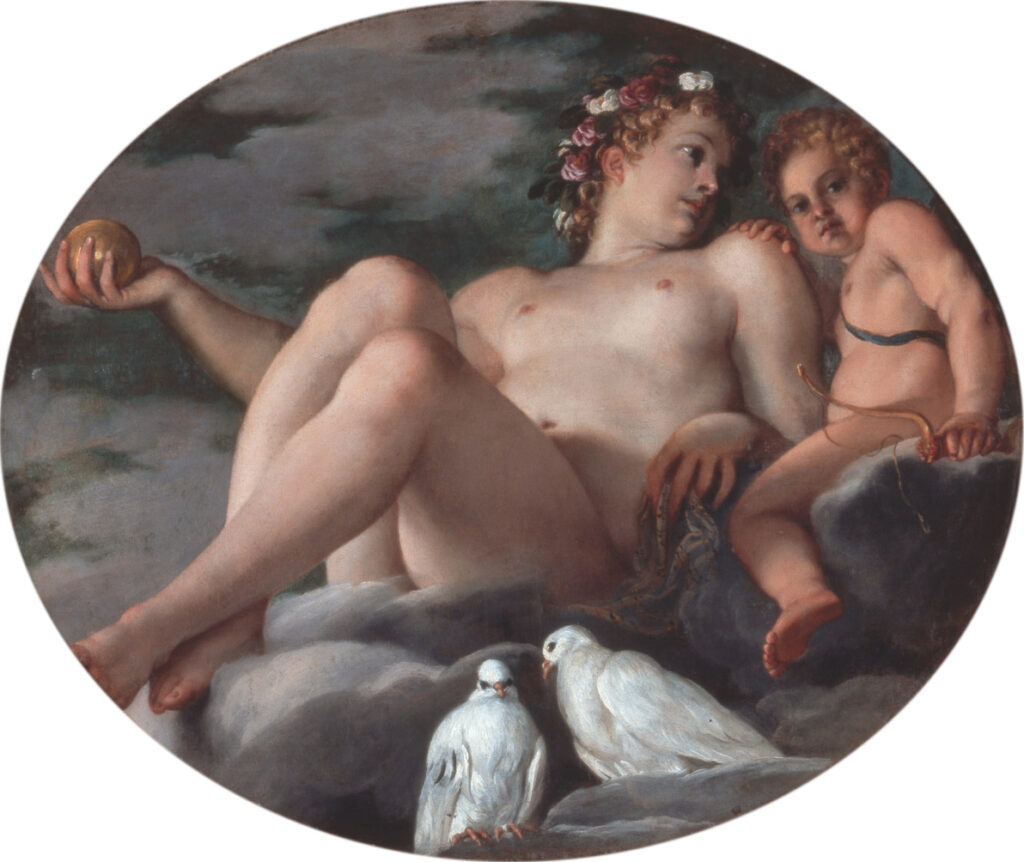

Modena the new capital
The loss of Ferrara was a hard blow for the Estense State, not only for the reduction of its territorial possessions, but above all because it lost its geographical centrality in Italian political life. That still remained Modena and Reggio.
The entry into Modena, according to Ludovico Antonio Muratori, took place on 30 January, on the eve of the feast of San Geminiano. The court following Caesar was small in compare to the Duke’s usual court and Modena also looked very different from the sumptuous Ferrara: the streets were small and dirty, the hygienic conditions poor and the population small. The Ducal Palace was not in a condition to receive the Duke and his Court on a permanent basis, so maintenance and new works were quickly started. Cesare had his flat adapted so that there would be space for his own personal chapel dedicated to the Nativity of the Virgin Mary. When the Este family arrived in Modena, there was no suitable place even for the precious works and books taken away from Ferrara, fortunately the ducal officer Ottonelli kept them at his residence.
The issue in Garfagnana: the war of 1602-1603 and 1613
Caesar’s meagre political experience led him to grant large powers to his prime minister, Giovanni Battista Laderchi, and his officials, who were often dishonest and incompetent.
The situation of governmental disorganisation was also reflected in the countryside, where the farmers were subjected to the abuse of feudal lords, whose violence was not contained by the central power. In addition, there were numerous disagreements between the nobles of Ferrara who moved to the new capital and the nobles of Modena, who were put on the back burner, stirring up controversy and new reasons for disorder.
The situation in which the Duchy found itself rekindled in the Republic of Lucca the desire to take possession of Garfagnana. From 1602 on, the Lucchese encroached several times on the Estensi’s territories, but the latter were always able to drive them back. The fighting, in which the town of Castelnuovo found itself involved, lasted only a few months, however, thanks to the intervention of the Governor of Milan, who postponed the decision on the Lombard town’s Court. In 1606 the Court of Milan ruled in favour of the Este family, but in 1612 the battles resumed and this time the Este army was led by Cesare’s sons Alfonso and Luigi. When the battle was at an end, an envoy from Milan arrived from the Spanish governor who proposed an agreement that the Este refused. He did, however, display the flag of Spain on the walls of Castiglione as a warning to Cesare, who again was in no position to enter into conflict against a great power.
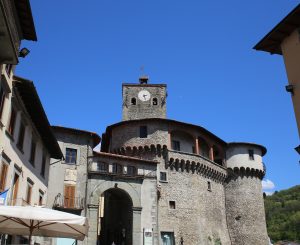
The Legacy of Alfonso III
The Devolution was followed by further territorial losses, as we have seen, and some politically important alliances were also lost. In 1615, the Duchess Virginia de’ Medici, a frail woman suffering from a mental illness, died. After her marriage, in fact, Virginia experienced mental problems, which, with the passage of time and especially following her numerous pregnancies, worsened her condition considerably. Thus a connection with the powerful Medici family, which in reality had had no real positive repercussions in Este politics, was dissolved.
Then, in 1624, Cardinal Alessandro died, who in the difficult years of settling in the new capital, knew how to stay close to Cesare by suggesting advice and carrying out ambassadorships with other states, first and foremost the Papal States.
It was during these years that alongside Cesare, in government activities, his eldest son Alfonso, to whom the Duchy was to pass in inheritance, had assumed increasing authority. Alfonso, unlike his father, had a strict and resolute character, present and interested in all the activities and affairs taking place in the territory, about which he demanded to be promptly informed. The strict control imposed by Alfonso led to an improvement in internal conditions by regulating the administration and its governors and limiting the power of the feudal lords. Cesare died on 11 December 1624, leaving behind a Duchy that was much reduced in size territorially and demographically, but Alfonso’s efforts had already laid the foundations to open a positive glimmer of hope for the Duchy’s fortunes.
The Ducal Chapel in Modena
As previously mentioned, Modena at the time of the arrival of the Duke and the Court was a medieval city, with narrow streets, poor hygienic conditions and without the architectural beauty of Ferrara. Cesare immediately set about renovating the castle and had part of the building facing the garden raised, from which he obtained his private flat consisting of three small rooms and a chapel. From documents of the time, we learn that this was inaugurated on 8 September 1605, the day dedicated to the Nativity of the Virgin Mary.
Initially the altarpiece was commissioned to Annibale Carracci and another painting to Caravaggio, works that never arrived, so the Duke, after waiting in vain for some time, decided to turn to other artists. Thus, Bartolomeo Schedoni (1578-1615), Ercole dell’Abate (1562-1613 nephew of Nicolò) and Ippolito Scarsella known as lo Scarsellino (c. 1550-1620) worked on the decoration of the private chapel. From inventory documents, scholars have been able to reconstruct the configuration of this space, which housed nine canvases by Schedoni, including the ‘Marriage of the Virgin’, Titian’s ‘Christ of the Coin’, now in the Gemaldegalerie in Dresden, the altarpiece with the ‘Nativity of the Virgin’ painted by Scarsellino and the ‘Presentation of the Virgin in the Temple’ by Ercole dell’Abate. This arrangement remained unchanged for a long time and only in 1783 did Ercole III remove some paintings.
The ‘Nativity of the Virgin’ painted by Scarsellino is dated 1607 and presents a highly theatrical narrative structure, highlighted by the skilful play of light and shadow. The centrepiece of the painting is the little baby girl, raised to heaven by the joined arms of her parents, St Anne and St Joachim. From a dense cloud crowded with cherubs emerges God the Father rejoicing at the birth of the future Mother of Christ. Around the sacred episode only female figures move, engaged in various activities related to the birth: on the left, the woman in the foreground carries a cradle and behind, another carries an amphora, while in the foreground a woman from behind leans on a wooden basin. The figure on the right is preparing to open the green curtain of the canopy on which Saint Anne is lying. In the lower part of the painting, the predominant colours are blue and yellow that emerge vigorously and vividly from the dark background, creating a strong contrast with the upper part, which is darker in tone.
On either side of the chapel’s smaller entrance were two paintings, the ‘Marriage of the Virgin’ and the ‘Presentation in the Temple’: both are set in an articulated architectural interior and show figures from behind used as a backdrop, thus isolating the central episode in the background. In the first work, painted by Schedoni, the religious scene takes place at the top of a staircase: the painter skilfully arranges the figures around the central scene in such a way as to facilitate and lead the viewer’s gaze. In the foreground is a young man with his back turned, looking out of the painting, inviting the observer to enter the conversation he is having with two elderly men, while behind them two men are climbing the stairs, bringing attention back to the focus of the representation. The background is organised by an imposing architecture animated by a crowd of people intent on witnessing the event.
The ‘Presentation of the Virgin in the Temple’ has a similar structure to the previous work: the foreground is occupied by the figure of a young woman seated with her back turned towards the spectator, next to her is a basket with a dove. The interior is marked by columns that lead the eye to the semicircular apse where, in front, the sacred scene unfolds. The figures huddling around the Virgin and the Priest show a more rapid stroke than those painted in the foreground.
The three paintings that embellished Cesare’s chapel, now conserved in the collections of the Galleria Estense in Modena, are a precious testimony of early 17th century Po Valley painting.

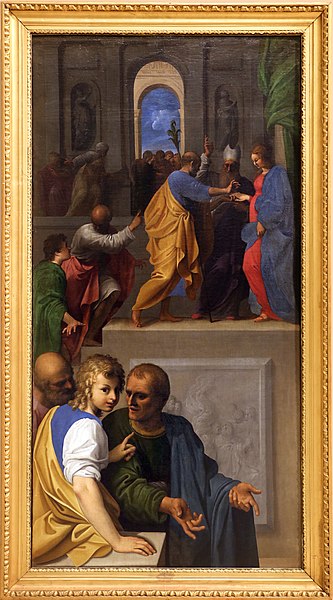
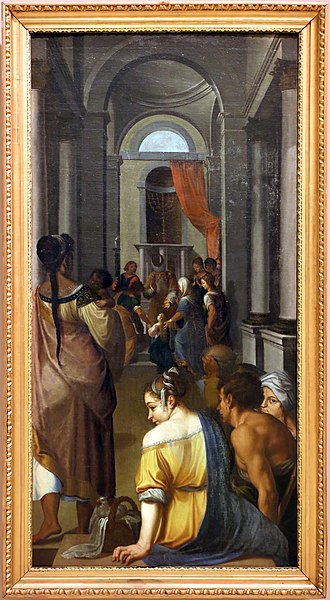
BIBLIOGRAPHY:
Modena 1598: l’invenzione di una capitale / edited by C. Conforti, G. Curcio, M. Bulgarelli. Milan, Electa, 1999
Cesare d’Este, the first duke of Modena capital : events and slanders concerning the creator of the State of Modena who was duke of Ferrara for three months and duke of Modena for thirty years / Gian Carlo Montanari Modena: Il fiorino, printed 2007
Cesare d’Este and Clement 8. / Alberto Gasparini Modena: Società Tipografica Editrice Modenese, printed 1960
Ritratti dei ser.mi Principi D’Este sig.ri di Ferrara con l’aggionta de loro fatti più memorabili ridotti in sommario dal s.r Antonio Cariola. Dedicati al ser.mo Alfonso IV. principe di Modona In Ferrara: appresso Catarin Doino, 1641 (In Ferrara: per Francesco Suzzi Stampator camerale, 1641)
“La chiesa di San Domenico a Modena “tempio palatino” Estense all’epoca del duca Cesare” by Graziella Martinelli Braglia in “Memorie Scientifiche, Giuridiche, Letterarie”, Accademia Nazionale di Scienze Lettere e Arti di Modena, Ser. IX, v. II (2018), fasc. I, 2019
Treccani Bibliographical Dictionary of Italians






